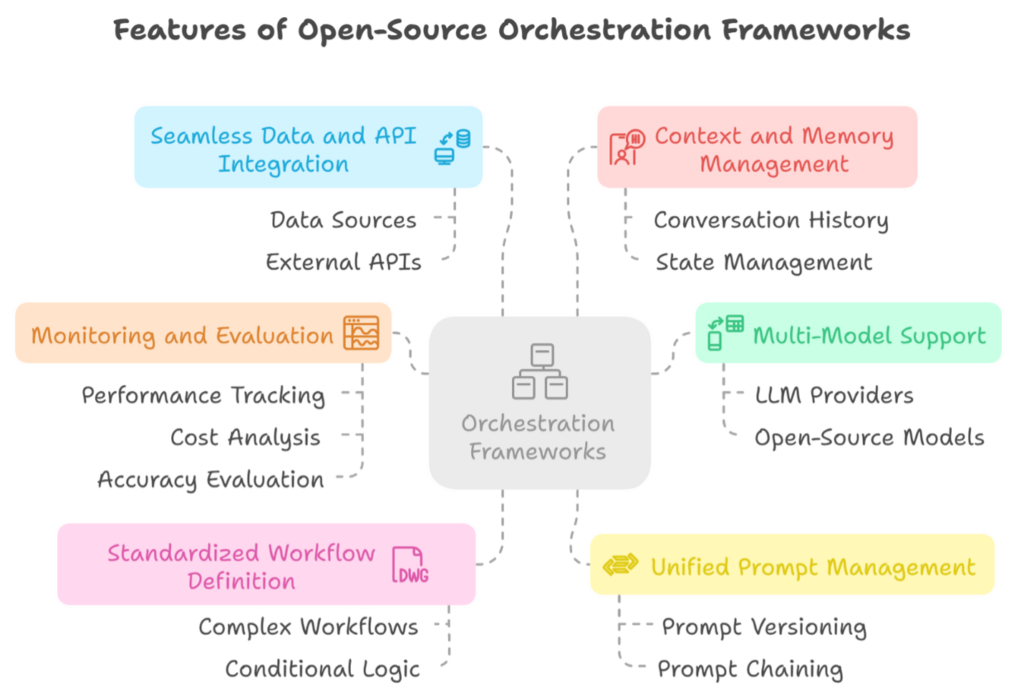
By Bala Kalavala, Chief Architect & Technology Evangelist
Orchestration Frameworks: Like a Conductor for AI
In the world of computers, “orchestration” is like a conductor leading a musical orchestra. It involves coordinating various computer systems, applications, and services to ensure they work together seamlessly to achieve a larger goal. For example, if you’re setting up a new website, orchestration can automate all the steps involved, such as preparing the server, installing the necessary software, and ensuring everything is connected correctly.
When it comes to large language models, orchestration frameworks are specialized tools that help manage and streamline the complex tasks involved in utilizing these powerful AI models. These frameworks facilitate tasks such as connecting different large language models (LLMs), using information from other sources, and recalling past interactions. Think back to the conductor analogy: the orchestration framework acts like the conductor, telling each part of the AI system – the LLM, a database of information, or an external service – when to “play” and what its role is in the overall performance.
Orchestration frameworks are crucial for developing sophisticated AI applications that can perform tasks beyond simply answering a single question. While a single LLM is proficient in understanding and generating text, many real-world AI applications require performing a series of steps involving different components. Orchestration frameworks provide the structure necessary to design and manage these complex workflows, ensuring that all the various components of the AI system work together efficiently.
Making LLMs Smarter Together: Prompt Chaining Explained
One way orchestration frameworks enhance the power of LLMs is through a technique known as “prompt chaining.” Think of it as telling a story one step at a time. Instead of giving the LLM a single, lengthy instruction, you provide it with a series of more minor, interconnected instructions known as prompts. The response from one prompt then becomes the starting point for the following prompt, guiding the LLM through a more complex thought process.
Open-source orchestration frameworks make it much simpler to create and manage these chains of prompts. They often provide tools that allow developers to easily link prompts together, sometimes through visual interfaces or programming tools.
Prompt chaining can be helpful in many situations. For example, if you want to create a blog post, you could use one prompt to generate an outline, the next to write the introduction, and then other prompts to write the different sections. This is like how you might write a school essay in stages. In customer service, a chatbot might use one prompt to understand a user’s problem, another to search for a solution in a database, and a final prompt to write a helpful reply. Or, if you’re analyzing data, you could use one prompt to extract key information from a document and another prompt to summarize it.
By breaking down complex tasks into smaller, more focused steps, prompt chaining enables developers to exert greater control over what the LLM produces. This step-by-step approach helps the LLM stay on track and make more accurate and detailed results for tasks that would be difficult to handle with a single prompt.
Standardizing GenAI Workflows: Orchestrating Multiple LLMs for Enterprise Advantage
The rapid advancement of Large Language Models (LLMs) presents unprecedented opportunities for enterprise innovation and efficiency. However, harnessing the full potential of these powerful AI tools at scale requires a strategic and standardized approach. This article examines how open-source orchestration frameworks enable organizations to effectively manage and integrate diverse large language models (LLMs) into cohesive workflows, driving tangible business value.
The Imperative for Standardized LLM Processes
While individual LLMs offer impressive capabilities, the reality of complex enterprise needs often necessitates leveraging multiple models, each with unique strengths in areas like reasoning, code generation, or specific domain expertise such as legal document analysis, medical diagnosis, or financial forecasting. Without a standardized process, managing these disparate models can lead to inefficiencies, increased costs, and a fragmented AI landscape.
Orchestration frameworks provide the crucial layer of abstraction necessary to establish consistent and repeatable workflows across various large language models (LLMs). This standardization is vital for cost optimization, improved performance, enhanced maintainability, and risk mitigation.
Orchestration Frameworks: The Conductor of Multi-LLM Workflows
Open-source orchestration frameworks act as central hubs for designing, deploying, and managing complex LLM-powered applications. They offer a range of features that facilitate the standardization of multi-LLM processes:
- Multi-Model Support: These frameworks are designed to be model-agnostic, allowing seamless integration with various LLM providers (e.g., OpenAI, Google, Anthropic) and open-source models. This flexibility enables organizations to select the most suitable model for each specific task within a workflow.
- Standardized Workflow Definition: Orchestration frameworks provide tools for visually designing and defining complex workflows that involve multiple LLM calls, conditional logic, and integration with external systems. This allows for the creation of repeatable and well-documented processes.
- Unified Prompt Management: Frameworks often include features for managing and versioning prompts, ensuring consistency in how different LLMs are instructed. Prompt chaining, a technique in which the output of one large language model (LLM) serves as the input for the next, is also a key capability for complex tasks.
- Seamless Data and API Integration: Orchestration frameworks simplify the process of connecting LLMs with various data sources (e.g., databases, vector stores) and external APIs. This enables LLMs to access real-time information and trigger actions in other systems within a standardized workflow.
- Context and Memory Management: Maintaining context across multiple LLM interactions is crucial for sophisticated applications. Orchestration frameworks provide mechanisms for managing conversation history and state, ensuring that different LLMs within a workflow can build upon previous interactions.
- Monitoring and Evaluation: Many frameworks offer built-in observability tools for tracking the performance, cost, and accuracy of LLM workflows. This allows for continuous improvement and optimization of standardized processes.

Visual: Features of Open-Source LLM Orchestration Frameworks
The adoption of LLM orchestration frameworks translates into significant strategic advantages for businesses, offering standardized workflows that bring agility and flexibility. This empowers teams to rapidly prototype and deploy new AI-powered applications, fostering innovation across the organization while reducing costs and streamlining governance and compliance.
Technologies involved in the development of LLM-based solutions can bring modularity and extensibility to the architecture, supporting simplified integration that enhances scalability and reliability.
Popular Open-Source Orchestration Frameworks
The fact that numerous open-source orchestration frameworks exist demonstrates the active and rapidly growing nature of the field of LLM development. Developers have a variety of tools to choose from depending on the specific needs of their projects. Several open-source frameworks have emerged as leaders in the LLM orchestration space, offering robust features for managing multi-LLM workflows
| Framework Name | Main Features | Primary Use Cases |
| LangChain | Versatile, connects to many data sources, APIs, and LLMs | Chatbots, question answering, summarization, agents |
| LlamaIndex | Focuses on connecting LLMs with private and domain-specific data | Document retrieval, knowledge-based chatbots |
| AutoGen | Enables building multi-agent conversational AI systems | Collaborative AI, complex task solving |
| Haystack | Strong in building search and question answering systems, emphasizes RAG | Question answering, document search, conversational AI |
| Orkes | Workflow engine for complex LLM applications | Real-time translation, automated content workflows |
| LLMFlow | A template-based approach for building simple and transparent LLM applications | Chatbots, Q&A;A systems, agents |
| Dify | Combines backend-as-a-service with LLMOps, intuitive prompt orchestration | Building AI applications with low-code workflows |
| Botpress | Platform for creating highly customizable chatbots across various channels | Customer service chatbots, conversational interfaces |
| Flowise | Low-code UI platform built on LangChain for creating LLM applications | Building AI agents and custom LLM workflows |
Table: Popular Open-Source LLM Frameworks
Open-source LLM orchestration frameworks are essential for organizations looking to transition from experimenting with LLMs to developing scalable and reliable GenAI applications. By standardizing multi-LLM workflows, these frameworks enable enterprises to leverage AI’s full potential, driving innovation and achieving significant outcomes. LLM orchestration is a strategic necessity for staying competitive in the evolving AI landscape.
Conclusion: The Future of AI Is Open and Collaborative
Open-source orchestration frameworks simplify the development of large language models. They offer tools for managing tasks such as prompt chaining, interfacing with APIs, fetching data, and working memory, enabling developers to create sophisticated AI applications. The collaborative nature of open-source software fosters rapid advancements. As AI becomes integral to daily life, understanding technologies like open-source orchestration will be crucial. Professionals exploring these concepts will be well-positioned to influence the future of this dynamic field.
Reference:
- LLM API’s: Tips for Bridging the Gap: https://www.ibm.com/think/insights/llm-apis
- Benefits and Limitations of LLM Models: https://web.dev/articles/ai-llms-benefits
- Top Open Source RAG Frameworks: https://dev.to/rohan_sharma/top-10-open-source-rag-frameworks-you-need-3fhe
Kalavala is a seasoned technologist who is enthusiastic about pragmatic business solutions influencing thought leadership. He is a sought-after keynote speaker, evangelist, and tech blogger. He is also a digital transformation business development executive at a global technology consulting firm, an Angel investor, and a serial entrepreneur with an impressive track record. The opinions expressed in this article are his own and do not necessarily reflect the views of his organization.
